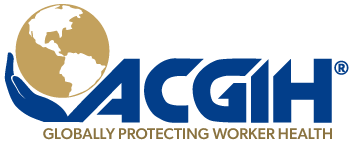- About
-
-

- About
-
ACGIH is a 501(c)(3) charitable scientific organization that advances occupational and environmental health.
-
-
- Subscriptions
-
- Science
-
-

- Science
-
This section has been established to help educate industry, government, and the public on what TLVs and BEIs are, and how TLVs and BEIs may best be used.
-
-
- Career Development
-
-

- Career Development
-
ACGIH is committed to providing its members and other occupational and environmental health professionals with the training and education they need to excel in their profession.
-
-
- Publications
-
-

- Publications
-
ACGIH has publications in many different areas that fit your needs in your field.
-
- Publications Store
- ACGIH Signature Publications
ACGIH Digital Library
If you need to purchase the Digital Library, click here.
If you have purchased and need to access the Digital Library, click here.
-
-
Webinar – The New Dimensions of Occupational Health – Impact of Industrial Hygiene
The objective of this presentation is to increase occupational health professionals’ awareness about this emerging situation and about the ways to deal with adequately.
Webinar – Global Understanding of Heat Stress and Heat-Related Illness for Workers and Communities
The basic understanding of heat stress and heat-related illness have been discussed based on a scientific perspective for both indoor and outdoor environments.
Webinar – IH Field Survey & Identification Technical Overview
IH Field Survey & Identification Technical Overview (Including Chemical, Biological, & Radiological Survey Instruments) – This technical session will focus on how advanced instrumentation devices are used to identify and classify materials in field settings. Instrumentation examples include simpler instruments such as CGI, ‘5-gas’, PIDs, and move on to more advanced spectral library-based instruments such as IR, FTIR, Raman, portable GC/MS, microscale MS (908), and Radioisotope Identification Devices (RIIDs).
Webinar – Industrial Air Cleaning Devices
This webinar will focus on ACGIH’s Chapter 8 of the Industrial Ventilation Manual for Design with an overview divided into two major sections as follows: 1. Particulate matter filtration and 2. Vapors and liquid filtration. In the first section, Fabric filters such as baghouse and the like will dominate with emphasis on problem particulate and how to fix these problems.
Webinar – Understanding Chemical Fume Hood and Laboratory HVAC Systems
Chemical fume hoods provide protection from vapors, splashes, fire, and impacts caused by chemicals and their reactions. However, fume hoods do not eliminate the hazards; they must be correctly used, maintained, and inspected to minimize the chance of exposure. We will explore why the correct laboratory ventilation is essential.
Webinar – The Hidden Occupational Hazard – Poor Indoor Air Quality
Join us as we explore the importance of maintaining healthy indoor air quality for your workforce. Attendees will learn: acceptable indoor air quality parameters, common sources of indoor air pollutants, signs of poor indoor air quality, and what to do when a complaint against indoor air quality is received.
Webinar – Biomechanics and Epidemiology of Shoulder Injuries
In this presentation we will breakdown the fundamental motions and biomechanics of the shoulder. After discussing the biomechanics of the shoulder, we will explore epidemiology research regarding the risk of shoulder injuries. We will also discuss techniques that can be used to accurately quantify the risk of shoulder injuries in the industrial setting and ways to mitigate risk.
Webinar – Improving Exposure Assessment – Tools for Emerging Professional’s Skill Enhancement
This presentation will enhance understanding of Industrial Hygiene (IH) for personnel with the responsibility of managing safety and health in the workplace, safety committee members, and other personnel responsible with the responsibility of minimizing health hazards in the workplace.
Complimentary Live Webinar – 2023 Updates to the TLVs and BEIs
This webinar will focus on updates to the 2023 TLVs, BEIs, and the process for recommending them. The committee meets regularly to update existing TLVs and to develop new ones based on a review of the literature and extensive discussion among committee members.
Webinar – Emerging Infectious Diseases and First Responders
At the conclusion of this course, participants will be able to apply the following: Define terms such as biological agent, bioterrorism and bioterrorism attack.





